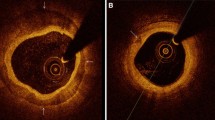Abstract
The presence of microcalcifications (µCalcs) >5 µm within the cap of human fibroatheroma has been shown to produce a 200–700 % increase in peak circumferential stress, which can transform a stable plaque into a vulnerable one, whereas µCalcs < 5 µm do not appear to increase risk. We quantitatively examine the possibility to distinguish caps with µCalcs > 5 µm based on the gross morphological features of fibroatheromas, and the correlation between the size and distribution of µCalcs in the cap and the calcification in the lipid/necrotic core beneath it. Atherosclerotic lesions (N = 72) were imaged using HR-μCT at 2.1-μm resolution for detailed analysis of atheroma morphology and composition, and validated using non-decalcified histology. At 2.1-μm resolution one observes four different patterns of calcification within the lipid/necrotic core, and is able to elucidate the 3D spatial progression of the calcification process using these four patterns. Of the gross morphological features identified, only minimum cap thickness positively correlated with the existence of µCalcs > 5 µm in the cap. We also show that µCalcs in the cap accumulate in the vicinity of the lipid/necrotic core boundary with few on the lumen side of the cap. HR-μCT enables three-dimensional assessment of soft tissue composition, lipid content, calcification patterns within lipid/necrotic cores and analysis of the axial progression of calcification within individual atheroma. The distribution of µCalcs within the cap is highly non-uniform and decreases sharply as one proceeds from the lipid pool/necrotic core boundary to the lumen.







Similar content being viewed by others
References
Burke AP, Farb A, Malcom GT, Liang Y, Smialek JE, Virmani R (1999) Plaque rupture and sudden death related to exertion in men with coronary artery disease. JAMA 281(10):921–926
Virmani R, Burke AP, Kolodgie FD, Farb A (2003) Pathology of the thin-cap fibroatheroma: a type of vulnerable plaque. J Interv Cardiol 16(3):267–272
Burke AP, Farb A, Malcom GT, Liang YH, Smialek J, Virmani R (1997) Coronary risk factors and plaque morphology in men with coronary disease who died suddenly. N Engl J Med 336(18):1276–1282
Virmani R, Narula J, Leon M, Willerson JTE (2007) The vulnerable atherosclerotic plaque: strategies for diagnosis and management. Blackwell, Malden
Vliegenthart R, Oudkerk M, Hofman A et al (2005) Coronary calcification improves cardiovascular risk prediction in the elderly. Circulation 112:572–577
Huang H, Virmani R, Younis H, Burke AP, Kamm RD, Lee RT (2001) The impact of calcification on the biomechanical stability of atherosclerotic plaques. Circulation 103(8):1051–1056
Vengrenyuk Y, Carlier S, Xanthos S, Cardoso L, Ganatos P, Virmani R et al (2006) A hypothesis for vulnerable plaque rupture due to stress-induced debonding around cellular microcalcifications in thin fibrous caps. Proc Natl Acad Sci USA 103(40):14678–14683
Maldonado N, Kelly-Arnold A, Vengrenyuk Y, Laudier D, Fallon JT, Virmani R et al (2012) A mechanistic analysis of the role of microcalcifications in atherosclerotic plaque stability: potential implications for plaque rupture. Am J Physiol Heart Circ Physiol 303(5):H619–H628
Maldonado N, Kelly-Arnold A, Cardoso L, Weinbaum S (2013) The explosive growth of small voids in vulnerable cap rupture; cavitation and interfacial debonding. J Biomech 46(2):396–401
Kelly-Arnold A, Maldonado N, Laudier D, Aikawa E, Cardoso L, Weinbaum S (2013) A revised microcalcification hypothesis for fibrous cap rupture in human coronary arteries. Proc Natl Acad Sci USA 110(26):10741–10746
Vengrenyuk Y, Cardoso L, Weinbaum S (2008) Micro-CT based analysis of a new paradigm for vulnerable plaque rupture: cellular microcalcifications in fibrous caps. Mol Cell Biomech 5(1):37
Vengrenyuk Y, Kaplan TJ, Cardoso L, Randolph GJ, Weinbaum S (2010) Computational stress analysis of atherosclerotic plaques in ApoE knockout mice. Ann Biomed Eng 38(3):738–747
Rambhia SH, Liang X, Xenos M, Alemu Y, Maldonado N, Kelly A et al (2012) Microcalcifications increase coronary vulnerable plaque rupture potential: a patient-based micro-CT fluid-structure interaction study. Ann Biomed Eng 40(7):1443–1454
Cardoso L, Kelly-Arnold A, Maldonado N, Laudier D, Weinbaum S (2014) Effect of tissue properties, shape and orientation of microcalcifications on vulnerable cap stability using different hyperelastic constitutive models. J Biomech 47(4):870–877
Cardoso L, Weinbaum S (2014) Changing views of the biomechanics of vulnerable plaque rupture: a review. Ann Biomed Eng 42(2):415–431
Palacio-Mancheno PE, Larriera AI, Doty SB, Cardoso L, Fritton SP (2014) 3D assessment of cortical bone porosity and tissue mineral density using high-resolution micro-CT: effects of resolution and threshold method. J Bone Miner Res 29(1):142–150
Hutcheson J, Maldonado N, Aikawa E (2014) Small entities with large impact: microcalcifications and atherosclerotic plaque vulnerability. Curr Opin Lipidol 25(5):327–332
Bobryshev YV, Killingsworth MC, Lord RS, Grabs AJ (2008) Matrix vesicles in the fibrous cap of atherosclerotic plaque: possible contribution to plaque rupture. J Cell Mol Med 12(5B):2073–2082
Roijers RB, Debernardi N, Cleutjens JP, Schurgers LJ, Mutsaers PH, van der Vusse GJ (2011) Microcalcifications in early intimal lesions of atherosclerotic human coronary arteries. Am J Pathol 178(6):2879–2887
New SEP, Aikawa E (2011) Molecular imaging insights into early inflammatory stages of arterial and aortic valve calcification. Circ Res 108(11):1381–1391
Ohayon J, Finet G, Gharib AM, Herzka DA, Tracqui P, Heroux J et al (2008) Necrotic core thickness and positive arterial remodeling index: emergent biomechanical factors for evaluating the risk of plaque rupture. Am J Physiol Heart Circ Physiol 295(2):H717–H727
Akyildiz AC, Speelman L, van Brummelen H, Gutierrez MA, Virmani R, van der Lugt A et al (2011) Effects of intima stiffness and plaque morphology on peak cap stress. Biomed Eng Online 10:25
Virmani R, Kolodgie FD, Burke AP, Farb A, Schwartz SM (2000) Lessons from sudden coronary death: a comprehensive morphological classification scheme for atherosclerotic lesions. Arterioscler Thromb Vasc Biol 20(5):1262–1275
Acknowledgments
This research has been supported by NIH HL101151, AG034198 and DK103362, National Science Foundation MRI 0723027, 1229449 and CMMI 1333560, and a Professional Staff Congress CUNY award.
Conflict of interest
None.
Author information
Authors and Affiliations
Corresponding author
Rights and permissions
About this article
Cite this article
Maldonado, N., Kelly-Arnold, A., Laudier, D. et al. Imaging and analysis of microcalcifications and lipid/necrotic core calcification in fibrous cap atheroma. Int J Cardiovasc Imaging 31, 1079–1087 (2015). https://doi.org/10.1007/s10554-015-0650-x
Received:
Accepted:
Published:
Issue Date:
DOI: https://doi.org/10.1007/s10554-015-0650-x




